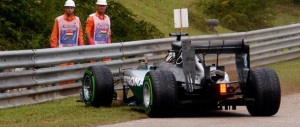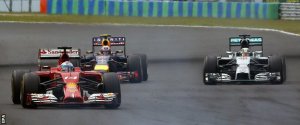After another dreadful qualifying session for Lewis Hamilton in 2014, the Briton looked certain to lose even more ground to Mercedes team-mate Nico Rosberg in the fight for the world drivers’ championship. Hamilton failed to set a time in Saturday qualifying, after a fuel leak on his Mercedes caused a huge fire putting Hamilton out and giving his Mercedes team a gigantic task to rebuild a car that was almost a total loss.
In contrast, as we’ve seen so many times this season, Rosberg had a trouble-free qualifying session. The German cruised to pole position by around half a second from the Red Bull Racing of Sebastian Vettel. It looked very much set fair for another win for the world drivers’ championship leader.
Sadly for Rosberg, though, the weather certainly wasn’t set fair. A huge downpour around 40 minutes before the start of the race threw a spanner in the works and added a huge amount of spice into the race mix. Nevertheless, though, Hamilton started the race in the worst possible position – the pitlane – and Rosberg in the very best starting spot. It would need a mighty drive from Hamilton, and some of the luck that had been so sorely missing from his season so far, if he was not to fall further behind in the championship race.
It certainly looked like luck was against Hamilton in the opening laps. The 2008 world drivers’ champion spun on the very first lap, on just the second corner of his race. Hamilton scraped the barrier, but crucially didn’t cause much damage to his car. Rosberg meanwhile, serenely streaked clear in the lead of the race. By lap eight, though, Hamilton had clawed his way up to 13th position, ahead of the Ferrari of Kimi Raikkonen, and then the safety car came out after Marcus Ericsson slammed his Caterham into the wall at turn three – a 20G impact.
Not only did the safety car wipe out Rosberg’s substantial lead over the second placed Williams of Valtteri Bottas, but it fell at an awful time for the German. Rosberg was unable to pit immediately as he’d already passed the pitlane meaning he, as well as Bottas, Vettel and Fernando Alonso in the Ferrari all had to do another lap while the rest of the field streamed in to change from intermediate tyres to, for the most part, soft option slick tyres.
Still, though, Rosberg was in fourth position while Hamilton was 13th as the restart was further delayed by Romain Grosjean crashing his Lotus with the safety car about to release the cars. All was not well with Rosberg, however. Smoke was coming from the left rear brake on his Mercedes and as the race restarted on lap 14 Rosberg fell like a stone.
Hamilton on the other hand, was going very much in the opposite direction. By lap 17 the two Mercedes cars were running fifth and seventh, with just the Red Bull of Vettel separating the two Silver Arrows. Another safety car came out on lap 23, however, as Sergio Perez slammed his Force India into the pit wall after spinning coming out of the final turn.
As the safety car came in on lap 27, Alonso led, while Rosberg was up to third and Hamilton fifth. There was no further progress for either driver until Rosberg pitted on lap 33. Almost immediately, Sebastian Vettel had an almost identical accident to Sergio Perez, but managing not to hit the pit wall as he spun out of the final corner. That let Hamilton through and straight onto the back of the out of position Toro Rosso of Jean-Eric Vergne, who had done a tremendous job to hold up Rosberg before the latter pitted.
He couldn’t do the same up against Lewis Hamilton, though, with the Englishman executing the pass of the race on lap 34 to pass the Frenchman around the outside of turn four. Hamilton was now second, with Rosberg 13th, but moving swiftly back up the field after his pit stop. Crucially, though, Hamilton was now a full pit stop ahead of his team-mate. When he eventually made his second stop on lap 40 – from the lead – and fitted the slower, but more durable medium compound slick tyres, we was able to emerge ahead of his team-mate in fifth position.
Rosberg was able to close up to Hamilton, but not close enough to make an overtaking manoeuvre. The team-mates were on different strategies. Rosberg was on the fast option tyres and due to stop once more, while Hamilton was on primes and due to run until the end of the race. Hamilton was asked by the team to let his team-mate through, but Rosberg was simply not close enough and Hamilton was unwilling to lose a significant amount of time to wave his championship rival through.
Ultimately, the decision to put Hamilton on an alternate strategy cost both him and Rosberg the chance to win the race. Hamilton was unable to close in on Alonso and Rosberg was unable to pass Hamilton, with Daniel Ricciardo leading the race by a significant distance from the Spaniard. Ricciardo pitted again for Fresh option on lap 54, rejoining behind Rosberg, with the latter making the same change on lap 56, emerging in seventh.
Alonso – on soft option tyres – led from Hamilton, but Ricciardo was closing rapidly on them both with his new rubber. Similarly Rosberg was catching the leaders at an alarming rate on his fresh tyres, but it was Ricciardo who was in the best position to win the race, and he duly did.
First of all he moved ahead of Hamilton around the outside of turn two on lap 67 and just a lap later overtook Alonso in turn one. The Australian was gone, but Rosberg was now on Hamilton’s tail. The Englishman was just able to hold his team-mate off to claim the final podium position and reduce the championship deficit to 11 points. An almost unthinkable result after their contrasting fortunes in qualifying.
It was Ricciardo who took his second win of the season, though. The Australian will be hugely satisfied with his performances at Red Bull, which have put his four-time world championship winning team-mate, Vettel, in the shade. As we head into the mid-season break, though, it’s Rosberg with the championship lead, albeit slightly reduced. Hamilton, though, may well think that the luck may now be turning in his favour.











